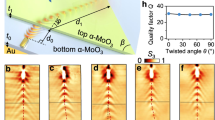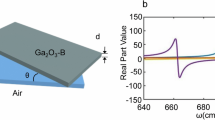Abstract
Hyperbolic polaritons facilitate nanoscale light manipulation, but strong field confinement limits their transmission across interfaces. Conversely, leaky waves can convert radiation from confined sources towards the far field. Here we combine hyperbolic polaritons and leaky wave radiation to demonstrate flatland leaky polaritonic wakes. We employ a mixed-dimensional van der Waals heterostructure consisting of a nanoscale waveguide strip on a van der Waals film. The waveguide mode, confined inside the hyperbolic light cone of the background film, enables efficient directional in-plane emission of fast phonon polaritons. The constructive interference of these leaky polaritons generates highly directional polaritonic wakes. Their spatial symmetry can be tailored through the orientation of the heterostructure with respect to the hyperbolic film dispersion. Leveraging van der Waals stacking, we also demonstrate effective acceleration and deceleration of polaritonic wakes by locally tailoring the leaky nano-waveguide dispersion through gradient thickness design. Our findings demonstrate that polaritonic wakes hold promise for integrated nanophotonic circuits.
This is a preview of subscription content, access via your institution
Access options
Access Nature and 54 other Nature Portfolio journals
Get Nature+, our best-value online-access subscription
$32.99 / 30 days
cancel any time
Subscribe to this journal
Receive 12 print issues and online access
$259.00 per year
only $21.58 per issue
Buy this article
- Purchase on SpringerLink
- Instant access to full article PDF
Prices may be subject to local taxes which are calculated during checkout




Similar content being viewed by others
Data availability
The data that support the findings of this study are available within the paper and the Supplementary Information. Source data are provided with this paper.
References
Zhang, Q. et al. Interface nano-optics with van der Waals polaritons. Nature 597, 187–195 (2021).
Wu, Y. et al. Manipulating polaritons at the extreme scale in van der Waals materials. Nat. Rev. Phys. 4, 578–594 (2022).
Guo, X. et al. Polaritons in van der Waals heterostructures. Adv. Mater. 35, 2201856 (2022).
Hu, H. et al. Far-field nanoscale infrared spectroscopy of vibrational fingerprints of molecules with graphene plasmons. Nat. Commun. 7, 12334 (2016).
Hu, H. et al. Gas identification with graphene plasmons. Nat. Commun. 10, 1131 (2019).
Dai, S. et al. Tunable phonon polaritons in atomically thin van der Waals crystals of boron nitride. Science 343, 1125–1129 (2014).
Ma, W. et al. In-plane anisotropic and ultra-low-loss polaritons in a natural van der Waals crystal. Nature 562, 557–562 (2018).
Taboada-Gutiérrez, J. et al. Broad spectral tuning of ultra-low-loss polaritons in a van der Waals crystal by intercalation. Nat. Mater. 19, 964–968 (2020).
Zheng, Z. et al. A mid-infrared biaxial hyperbolic van der Waals crystal. Sci. Adv. 5, eaav8690 (2019).
Wang, C. et al. Van der Waals thin films of WTe2 for natural hyperbolic plasmonic surfaces. Nat. Commun. 11, 1158 (2020).
Ni, X. et al. Observation of directional leaky polaritons at anisotropic crystal interfaces. Nat. Commun. 14, 2845 (2023).
Teng, H. et al. Steering and cloaking of hyperbolic polaritons at deep-subwavelength scales. Nat. Commun. 15, 4463 (2024).
Ma, W. et al. Ghost hyperbolic surface polaritons in bulk anisotropic crystals. Nature 596, 362–366 (2021).
Passler, N. C. et al. Hyperbolic shear polaritons in low-symmetry crystals. Nature 602, 595–600 (2022).
Hu, G. et al. Real-space nanoimaging of hyperbolic shear polaritons in a monoclinic crystal. Nat. Nanotechnol. 18, 64–70 (2023).
Hu, H. et al. Gate-tunable negative refraction of mid-infrared polaritons. Science 379, 558–561 (2023).
Sternbach, A. et al. Negative refraction in hyperbolic hetero-bicrystals. Science 379, 555–557 (2023).
Álvarez-Pérez, G. et al. Negative reflection of nanoscale-confined polaritons in a low-loss natural medium. Sci. Adv. 8, eabp8486 (2022).
Zhang, T., Zheng, C., Chen, Z. N. & Qiu, C. W. Negative reflection and negative refraction in biaxial van der Waals materials. Nano Lett. 22, 5607–5614 (2022).
Duan, J. et al. Planar refraction and lensing of highly confined polaritons in anisotropic media. Nat. Commun. 12, 4325 (2021).
Zhang, Q. et al. Unidirectionally excited phonon polaritons in high-symmetry orthorhombic crystals. Sci. Adv. 8, eabn9774 (2022).
Moccia, M., Castaldi, G., Alù, A. & Galdi, V. Leaky waves in flatland. Adv. Opt. Mater. 12, 2203121 (2024).
Monticone, F. & Alu, A. Leaky-wave theory, techniques, and applications: from microwaves to visible frequencies. Proc. IEEE 103, 793–821 (2015).
Karl, N. J., McKinney, R. W., Monnai, Y., Mendis, R. & Mittleman, D. M. Frequency-division multiplexing in the terahertz range using a leaky-wave antenna. Nat. Photon. 9, 717–720 (2015).
Matsumoto, H., Watanabe, I., Kasamatsu, A. & Monnai, Y. Integrated terahertz radar based on leaky-wave coherence tomography. Nat. Electron. 3, 122–129 (2020).
Huang, H. et al. Leaky-wave metasurfaces for integrated photonics. Nat. Nanotechnol. 18, 580–588 (2023).
Kong, G. S., Ma, H. F., Cai, B. G. & Cui, T. J. Continuous leaky-wave scanning using periodically modulated spoof plasmonic waveguide. Sci. Rep. 6, 29600 (2016).
Alù, A., Bilotti, F., Engheta, N. & Vegni, L. Subwavelength planar leaky-wave components with metamaterial bilayers. IEEE Trans. Antennas Propag. 55, 882–891 (2007).
Hu, G. et al. Topological polaritons and photonic magic angles in twisted α-MoO3 bilayers. Nature 582, 209–213 (2020).
Chen, M. et al. Configurable phonon polaritons in twisted α-MoO3. Nat. Mater. 19, 1307–1311 (2020).
Duan, J. et al. Twisted nano-optics: manipulating light at the nanoscale with twisted phonon polaritonic slabs. Nano Lett. 20, 5323–5329 (2020).
Zheng, Z. et al. Phonon polaritons in twisted double-layers of hyperbolic van der Waals crystals. Nano Lett. 20, 5301–5308 (2020).
Liu, F. et al. Integrated Cherenkov radiation emitter eliminating the electron velocity threshold. Nat. Photon. 11, 289–292 (2017).
Lin, X. et al. Controlling Cherenkov angles with resonance transition radiation. Nat. Phys. 14, 816–821 (2018).
Xue, S., Zeng, Y., Bao, Q., Zhu, S. & Chen, H. Tunable Cherenkov radiation based on a van der Waals semiconductor α-MoO3 and graphene hybrid. Opt. Lett. 47, 2458–2461 (2022).
Hu, H. et al. Surface Dyakonov–Cherenkov radiation. eLight 2, 2 (2022).
Pons-Valencia, P. et al. Launching of hyperbolic phonon-polaritons in h-BN slabs by resonant metal plasmonic antennas. Nat. Commun. 10, 3242 (2019).
Maciel-Escudero, C., Konečná, A., Hillenbrand, R. & Aizpurua, J. Probing and steering bulk and surface phonon polaritons in uniaxial materials using fast electrons: hexagonal boron nitride. Phys. Rev. B 102, 115431 (2020).
Moccia, M., Castaldi, G., Alù, A. & Galdi, V. Exploring interface effects in flatland optics. In 2023 Seventeenth International Congress on Artificial Materials for Novel Wave Phenomena (Metamaterials) X-114–X-116 (IEEE, 2023).
Sun, Y. et al. Direct measurement of polariton–polariton interaction strength. Nat. Phys. 13, 870–875 (2017).
Zhang, Y. et al. Tunable Cherenkov radiation of phonon polaritons in silver nanowire/hexagonal boron nitride heterostructures. Nano Lett. 20, 2770–2777 (2020).
Guo, X. et al. Mid-infrared analogue polaritonic reversed Cherenkov radiation in natural anisotropic crystals. Nat. Commun. 14, 2532 (2023).
Hu, H. et al. Doping-driven topological polaritons in graphene/α-MoO3 heterostructures. Nat. Nanotechnol. 17, 940–946 (2022).
Ruta, F. L. et al. Surface plasmons induce topological transition in graphene/α-MoO3 heterostructures. Nat. Commun. 13, 3719 (2022).
Hu, H. et al. Active control of micrometer plasmon propagation in suspended graphene. Nat. Commun. 13, 1465 (2022).
Qu, Y. et al. Tunable planar focusing based on hyperbolic phonon polaritons in α-MoO3. Adv. Mater. 34, 2105590 (2022).
Correas-Serrano, D. & Gomez-Diaz, J. S. Nonreciprocal and collimated surface plasmons in drift-biased graphene metasurfaces. Phys. Rev. B 100, 081410 (2019).
Rus, J., Bossart, A., Apffel, B., Malléjac, M. & Fleury, R. Experimental observation of parabolic wakes in thin plates. Phys. Rev. Res. 6, L032027 (2024).
Chaves, A. J., Peres, N. M. R., Smirnov, G. & Mortensen, N. A. Hydrodynamic model approach to the formation of plasmonic wakes in graphene. Phys. Rev. B 96, 195438 (2017).
Acknowledgements
We acknowledge X. Xi and X. Wang (State Key Laboratory of New Ceramics & Fine Processing, Tsinghua University) for scanning near-field optical microscopy measurements and valuable discussions, and are grateful to X. Li (Institutional Center for Shared Technologies and Facilities of Institute of Process Engineering, Chinese Academy of Sciences) for assistance with structural fabrication and characterization. Q.D., H.H. and their team were supported by the National Key Research and Development Program of China (grant no. 2021YFA1201500 to Q.D.), the National Natural Science Foundation of China (grant nos. 52322209, 52172139 and 52350314 to H.H.; grant no. 51925203 to Q.D.), Beijing Nova Program (grant nos. 2022012 and 20240484600 to H.H.) and the Youth Innovation Promotion Association of the Chinese Academy of Sciences (grant no. 2022037 to H.H.). N.C. was supported by the Postdoctoral Fellowship Program and China Postdoctoral Science Foundation (grant nos. BX20250181 and 2024M760685). A.A. was supported by the Office of Naval Research (grant no. N00014-2212448), the Air Force Office of Scientific Research and the Simons Foundation.
Author information
Authors and Affiliations
Contributions
Q.D. and H.H. conceived the idea. Q.D. and A.A. supervised the project. N.C. and H.H. led the experiments, prepared the samples and performed the near-field measurements. H.T. and A.A. developed the theory and performed the simulation. N.C., H.T. and H.H. analysed the data, and all authors discussed the results. M.L., C.J., Z.X., H.Z. and J.G. provided experimental and simulation assistance. H.H., N.C., H.T. and Q.D. cowrote the paper, with input and comments from all other authors.
Corresponding authors
Ethics declarations
Competing interests
The authors declare no competing interests.
Peer review
Peer review information
Nature Materials thanks the anonymous reviewers for their contribution to the peer review of this work.
Additional information
Publisher’s note Springer Nature remains neutral with regard to jurisdictional claims in published maps and institutional affiliations.
Supplementary information
Supplementary Information
Supplementary Figs. 1–19 and Notes 1–5.
Source data
Source Data Fig. 4
Statistical source data.
Rights and permissions
Springer Nature or its licensor (e.g. a society or other partner) holds exclusive rights to this article under a publishing agreement with the author(s) or other rightsholder(s); author self-archiving of the accepted manuscript version of this article is solely governed by the terms of such publishing agreement and applicable law.
About this article
Cite this article
Chen, N., Teng, H., Hu, H. et al. Flatland wakes based on leaky hyperbolic polaritons. Nat. Mater. 24, 1569–1575 (2025). https://doi.org/10.1038/s41563-025-02280-0
Received:
Accepted:
Published:
Issue date:
DOI: https://doi.org/10.1038/s41563-025-02280-0



